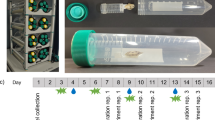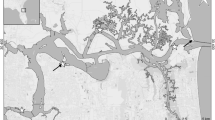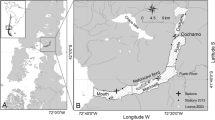Abstract
Aggregation of blue mussels (Mytilus edulis) is stimulated by environmental chemical stimuli. Experiments carried out in a basin with a one-way current showed that individual mussels were attracted to upstream mussel concentrations and moved actively in their direction. The involvement of a tripeptide in this migration was implicated by experiments demonstrating that individual mussels were effectively attracted and moved actively towards a source of glycine–glycine–arginine at concentrations of 0.56–3.78×10–10 M. A distinct seasonal difference in the extent of movement towards mussel concentrations was found. From the beginning of autumn, movement decreases linearly towards zero movement in winter.



Similar content being viewed by others
References
Browne AK, Zimmer RK (2001) Controlled field release of a waterborne chemical signal stimulates planktonic larvae to settle. Biol Bull (Woods Hole) 200:87–91
Browne AK, Tamburri MN, Zimmer-Faust RK (1998) Modelling quantitative structure–activity relationships between animal behaviour and environmental signal molecules. J Exp Biol 201:245–258
Clare AS, Yamazaki M (2000) Inactivity of glycyl–glycyl–arginine and two putative (QSAR) peptide analogues of barnacle waterborne settlement pheromone. J Mar Biol Assoc UK 80:945–946
de Vooys CGN (1976) The influence of temperature and time of year on the oxygen uptake of the sea mussel Mytilus edulis. Mar Biol 36:25–30
Decho AW, Browne KA, Zimmer-Faust RK (1998) Chemical cues: why basic peptides are signal molecules in marine environments. Limnol Oceanogr 43:1410–1417
Forward RF, Rittschof D, De Vries MC (1987) Peptide pheromones synchronize crustacean egg hatching and larval release. Chem Senses 12:491–498
Kuenen DJ (1942) On the distribution of mussels on the intertidal sand flats near Den Helder. Arch Neerl Zool 6:117–160
Maas Geesteranus RA (1942) On the formation of banks by Mytilus edulis L. Arch Neerl Zool 6:283–326
McGrorty S, Goss-Custard JD (1991) Population dynamics of the mussel Mytilus edulis: spatial variations in age-class densities of an intertidal estuarine population along environmental gradients. Mar Ecol Prog Ser 73:191–202
Nowell ARM, Jumars PA (1987) Flumes: theoretical and experimental considerations for simulation of benthic environments. Oceanogr Mar Biol Annu Rev 25:91–112
Okamura B (1986) Group living and the effects of spatial positions in aggregations of Mytilus edulis. Oecologia 69:341–347
Petraitis PS (1987) Immobilization of the predatory gastropod, Nucella lapillus, by its prey Mytilus edulis. Biol Bull (Woods Hole) 172:307–314
Rittschof D (1990) Peptide-mediated behaviors in marine organisms. Evidence for a common theme. J Chem Ecol 16:261–272
Rittschof D (1993) Body odors and neutral–basic peptide mimics: a review of responses by marine organisms. Am Zool 33:487–493
Rittschof D, Forward RB, Simons DA, Reddy PA, Erickson BW (1989) Peptide analogs of the mud crab pumping pheromone: structure–function studies. Chem Senses 14:137–148
Svane I, Ompi M (1993) Patch dynamics in beds of the blue mussel Mytilus edulis L.: effects of site, patch size and position within a patch. Ophelia 37:187–202
Tamburri MN, Finelli CM, Wethey DS, Zimmer-Faust RK (1996) Chemical induction of larval settlement behavior in flow. Biol Bull (Woods Hole) 191:367–373
Tegtmeyer K, Rittschof D (1989) Synthetic peptide analogs to barnacle settlement pheromone. Peptides 9:1403–1406
Turner EJ, Zimmer-Faust RK, Palmer MA, Lukenbach M, Pentcheff ND (1994) Settlement of oyster (Crassostrea virginica) larvae: effects of water flow and a water-soluble chemical clue. Limnol Oceanogr 39:1579–1593
Walther M, Fleck J (1998) Synthetic peptides inducing metamorphosis in a tropical jellyfish: a quantitative structure–activity relationship study. Comp Biochem Physiol A 120:655–659
Young GA (1983) The effect of sediment type upon the position and depth at which byssal attachment occurs in Mytilus edulis. J Mar Biol Assoc UK 63:641–651
Zimmer RK, Butman CA (2000) Chemical signaling processes in the marine environment. Biol Bull (Woods Hole) 198:168–187
Zimmer-Faust RK, Tamburri MN (1994) Chemical identity and ecological implications of a waterborne, larval settlement cue. Limnol Oceanogr 39:1075–1087
Acknowledgements
The author wishes to thank Dr N. Dankers for providing the facilities at ALTERRA and for his interest in the problem, Dr J. van der Meer for statistical advice on the data analysis and also Mr A. Meyboom and Mr A. Sleutel for their helpfulness during the investigation.
Author information
Authors and Affiliations
Additional information
Communicated by O. Kinne, Oldendorf/Luhe
Rights and permissions
About this article
Cite this article
de Vooys, C.G.N. Effect of a tripeptide on the aggregational behaviour of the blue mussel Mytilus edulis . Marine Biology 142, 1119–1123 (2003). https://doi.org/10.1007/s00227-003-1039-2
Received:
Accepted:
Published:
Issue Date:
DOI: https://doi.org/10.1007/s00227-003-1039-2




